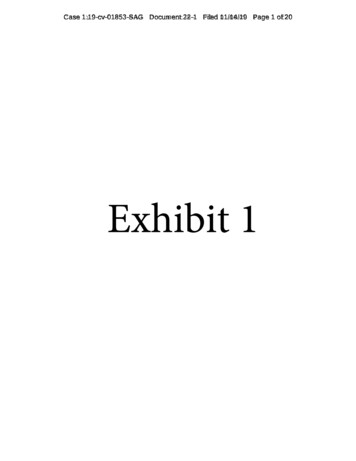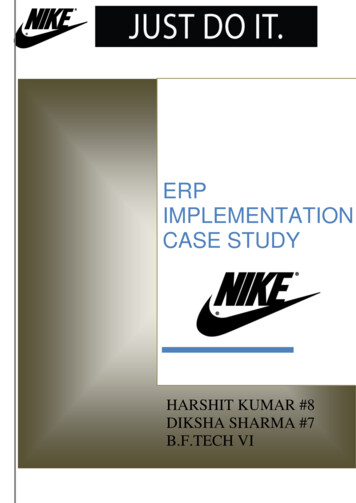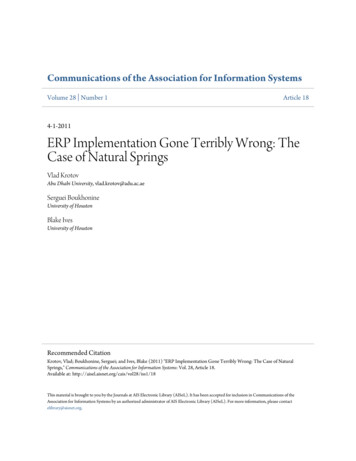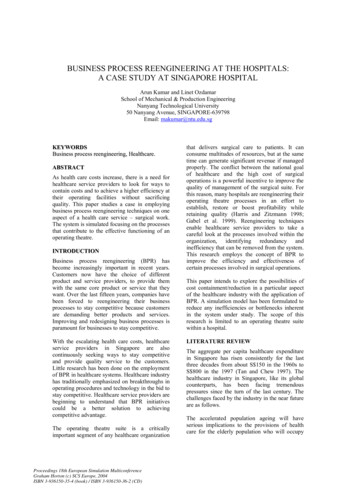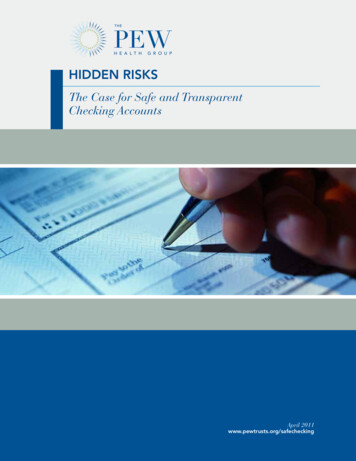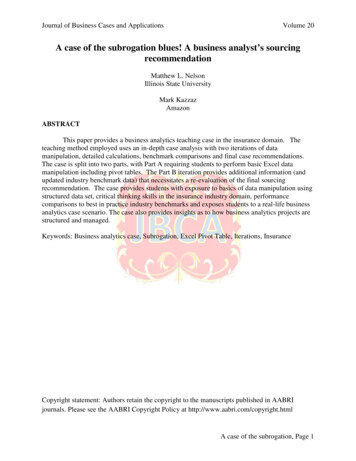
Transcription
Journal of Business Cases and ApplicationsVolume 20A case of the subrogation blues! A business analyst’s sourcingrecommendationMatthew L. NelsonIllinois State UniversityMark KazzazAmazonABSTRACTThis paper provides a business analytics teaching case in the insurance domain. Theteaching method employed uses an in-depth case analysis with two iterations of datamanipulation, detailed calculations, benchmark comparisons and final case recommendations.The case is split into two parts, with Part A requiring students to perform basic Excel datamanipulation including pivot tables. The Part B iteration provides additional information (andupdated industry benchmark data) that necessitates a re-evaluation of the final sourcingrecommendation. The case provides students with exposure to basics of data manipulation usingstructured data set, critical thinking skills in the insurance industry domain, performancecomparisons to best in practice industry benchmarks and exposes students to a real-life businessanalytics case scenario. The case also provides insights as to how business analytics projects arestructured and managed.Keywords: Business analytics case, Subrogation, Excel Pivot Table, Iterations, InsuranceCopyright statement: Authors retain the copyright to the manuscripts published in AABRIjournals. Please see the AABRI Copyright Policy at http://www.aabri.com/copyright.htmlA case of the subrogation, Page 1
Journal of Business Cases and ApplicationsVolume 201. INTRODUCTIONThe popularity of business analytics (BA) programs and courses in business schools aregrowing dramatically (Turel 2016). Despite this growth, industry demands for BA skill sets andemployees far exceed the supply from academia (Solomon, 2014, Turel 2016). Development ofgeneral business analytics courses at the undergraduate and graduate levels that comprehendtopics and technologies across all business majors are important avenues towards reducing thisskills gap and meeting employer BA needs moving forward (Haan 2015, Turel 2016). Althoughthis case concentrates on one particular business domain in the insurance industry of subrogationsourcing decisions, the case techniques and methodologies can be generalized across businessdisciplines.The simplest definition of subrogation is defined as “to put into the place of another”(Dictionary 2018). More specifically, in an insurance domain context, the act of subrogating isdefined as “the assumption by a third party (such as a second creditor or an insurance company)of another’s legal right to collect a debt or damage” (Merriam-Webster 2018). Most students aresurprised to learn that they have already experienced the act of subrogation with automotiveinsurance claims, although they had not realized it. For example, when a person is involved in acar accident and rather than waiting for fault to be determined and the law suit(s) to be settled,most drivers will assign their right to sue to their auto insurance company in order to get their carrepaired as quickly as possible. In return, their Insurance company pays in advance for theautomobile(s) to be repaired immediately rather than waiting for the final judgement(s). Oncethe final fault judgements are determined and / or the settlement(s) have been negotiated, theclaims are paid and settled-up between the insured and the insurance companies accordingly.The subrogation industry has grown beyond automotive insurance claims, to propertysubrogation, worker’s compensation subrogation, healthcare subrogation, bad debts collectionand more (NASP 2018).Larger insurance carriers sometimes experience difficulties and / or lengthy delays incollecting on subrogated claims from smaller insurance carriers, however, due to the smallerfirm’s limited financial resources and lack of in-house legal expertise with the processing ofsubrogated claims. As a result, some insurance carriers choose to outsource the processing andcollection of subrogated insurance claims to niche firms who specialize in this area.Here lies the fundamental question in the case, should the business analyst recommend tohis insurance company’s management team to outsource or keep in-house the processing ofsubrogated automotive insurance claims? Part A of the case requests students to prepare aqualitative SWOT analysis of the outsourcing decision, as well as to prepare a quantitativeanalysis of the outsourcing decision. Part A also request students to benchmark performanceversus industry averages and to make and defend a formal sourcing decision. Building on theseresults, Part B introduces additional information pertinent to the sourcing decision and requestsstudents to conduct an additional iteration of quantitative analysis, benchmarking performanceand to re-evaluate their sourcing recommendation to the management team.2. LEARNING OBJECTIVES, CASE SETTING & PEDAGOGICAL USESThe case is developed based on a real-life business analytics project. At the company’srequest, their name is withheld from the case and instead a fictional company name of AIC (AnInsurance Company) is used. AIC is a United States based mid-sized automotive insuranceA case of the subrogation, Page 2
Journal of Business Cases and ApplicationsVolume 20provider who provides insurance coverage in three lines personal automobile, commercialautomobile, non-standard automobile. The case is intended for an undergraduate BusinessAnalytics course. The course is required for all Business Analytics majors regardless of thespecific area in analytics that they choose to concentrate. As a result, the course is designed tobe cross-disciplinary in that the text, the cases, and course activities encompass multipledisciplines in the business college (e-commerce, accounting, insurance, information systems,etc.) An important theme and student outcome of the course are the triple E’s (exposure,explore and experience). That is, the course is designed and students are informed that numerousBA tools, methods and technologies are introduced through-out the semester. Far more than theallotted weekly class meeting time (two 75-minute sessions per week for 15 weeks) will permitfor comprehensive coverage. Thus, students are consistently reminded that class meetings areintended to provide initial ‘Exposure’, but it is the student’s responsibility to further ‘Explore’and to gain as much ‘Experience’ using the variety of BA tools and technologies fromthroughout the semester. Additional learning objectives of the case include critical thinking inthe following;Exposure to structured data manipulation concepts and techniques using Microsoft Excel.Hands on experience working on a real life BA caseUnderstand how industry benchmarking and best practices influence a company’s criticaldecision makingGreater understanding of the insurance domain and specifically in automotive insurancesubrogation practicesBasic understanding of the iterative nature of business analytics projects3. CASE ANALYSIS PART A - FIRST ITERATIONThis section provides case questions, responses and highlights teaching methods used in PartA of the case. This is also referred to as the students’ first iteration of conducting the caseanalysis (qualitatively, quantitatively, and making a formal recommendation.) The threequestions from Part A of the case are as follows:A1. Prepare a Qualitative Assessment of AIC’s decision to outsource the processing of theirsubrogated insurance claimsA2. Prepare a ‘current’ quantitative assessment of AIC’s performance metrics to processingsubrogated claims and to compare this performance to industry averages / best practices.A3. Make a recommendation to AIC’s management as to how they process subrogatedclaims (internally or should they be outsource)?Students are provided a data set of claim records from AIC. Using Excel, students areexpected to calculate the following performance metrics of AIC’s processing of subrogatedautomotive insurance claims across three product lines (personal automobile, commercialautomobile, non-standard automobile.)New subrogation files opened as % of new reported claimsTotal s of net subrogation recoveries as a % of Total Indemnity Paid LosesAverage Time to Closure after Subrogation Potential is IdentifiedAppendix A includes the Total Universe and High Performers industry benchmark data asprovided by the NASP. The results of the benchmarking versus AIC (in general) can beinterpreted in the following manner. If AIC’s portfolio of subrogation claims as % of newreport claims exceeds the industry average, then this may indicate AIC has greater risk in theirA case of the subrogation, Page 3
Journal of Business Cases and ApplicationsVolume 20customer base than the industry (overall.) This result could influence AIC’s decisionoutsourcing decision as well as other risk mitigation procedures. Similarly, if AIC earns greaterrecoveries from processing their subrogated claims internally (compared to industry averages)then this could influence their decision to keep the processing internally. Alternatively, if AICtime to close subrogated claims is two or three times longer than industry averages, then thisresult should definitely require AIC to closely examine their subrogation business process (stepby step) to understand why they require so much more time than the rest of the industry.Similarly, this result could influence AIC’s decision to outsource the subrogated businessprocessing.3.1 Qualitative AssessmentSimilar to many outsourcing considerations made by companies, some of the expectedresponses to question one of the qualitative considerations of AIC’s decision to outsource theprocessing and collections of subrogated claims include the following;Strengths of the Outsourcing DecisionEnables internal employees to focus more on core business processes and service lines.Could be an effective risk mitigation technique with riskier subrogated claimsAllows AIC to address benchmark results where AIC is significant different than theirpeersWeaknesses of the Outsourcing DecisionAIC loses the expertise of internally processing and collections of a niche but growingsegment of their business.AIC will lower their control over their subrogated claims processing.The business process could take longer to complete with the outsourced company and/orresult in lower recoveries.Opportunities of the Outsourcing DecisionAIC could earn greater recoveriesAIC could earn or reduce the time to closure of subrogated claims.AIC could spend more time and build new business lines with employees spending moretime other areas of the business.Threats of the Outsourcing DecisionThe outsourced firm could raise costs / charge higher fees over the long termAIC could lose long-term business clients through outsourcing this to a different firmAIC could risk be liable for mistakes made / illicit practices of the outsourcing firm.3.2 Quantitative AssessmentThe quantitative results from question two of the case are summarized in Appendix A.Students use the data set that accompanies this case in order to calculate AIC’s results. Studentshave the option of using Excel’s data management functions to calculate the results, or they canselect the much faster route by using Excel’s PivotTable functions. In-class time is spent withdemonstrating PivotTables, defining and explaining the meaning of data fields and records in thedata set. The data records are cleaned prior to distributing to the students and the data values arechanged from one semester to another in order to reduce the likelihood of students sharing theA case of the subrogation, Page 4
Journal of Business Cases and ApplicationsVolume 20results of the case analysis with students in future courses. The industry benchmarking resultsare provided through National Association of Subrogation Professionals (NASP 2008).3.3 RecommendationThe fundamental question facing the business analyst is should AIC outsource the processingof subrogated claims to an outside (third party) firm who specializes in the processing, collectionand closure of subrogated automotive claims? Stated in a slightly different, should AIC makechanges in their portfolio of automotive claims by product line or by sourcing? The mostcommon observations made by students based on the benchmarking of AIC’s quantitative resultsto NASP’s industry data are the following.In Table A (from Appendix A) with New Subrogation Files opened as % of New Claims,AIC is outperforming the industry in the Personal Automotive service line with only10.3% of its’ new claims going into subrogation versus the industry average of 15.7%.AIC is very consistent with the industry averages in their Commercial Automotiveservice line (12%) and underperforming compared to industry averages in their NonStandard Automobile line (19.7% versus the industry average of 15.7%).In Table B (from Appendix A), we learn that AIC outperforms Industry Averages withearning greater net recoveries in two product lines (personal and commercial) butsignificantly underperforms versus the rest of the industry in the third service line Nonstandard Automobiles (8.8 cents on the dollar of paid losses versus the industry averageof 12.4 cents.)In Table C (from Appendix A), we learn that AIC takes longer to close subrogated fileswhen compared to industry averages across all service lines. Specifically, it takes AICfour additional days to close subrogated claims with personal autos, 12 additional dayswith commercial autos, and 11 additional days with non-standard autos.At the end of case’s first iteration, the written responses and classroom discussion of thecase, most student recommendations will begin to separate their recommendations by productline. That is, given the facts and assumptions in the case at this point, their analysis will showthat AIC performs quite well in two product lines (personal and commercial auto) in theprocessing of subrogated claims when compared to industry averages. Their processing of nonstandard subrogated auto claims however i
this case concentrates on one particular business domain in the insurance industry of subrogation sourcing decisions, the case techniques and methodologies can be generalized across business disciplines. The simplest definition of subrogation is defined as “to put into the place of another” (Dictionary 2018). More specifically, in an insurance domain context, the act of subrogating is .





